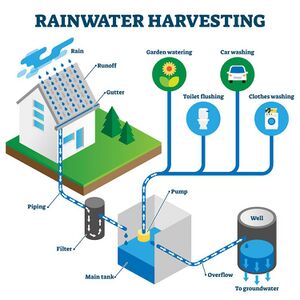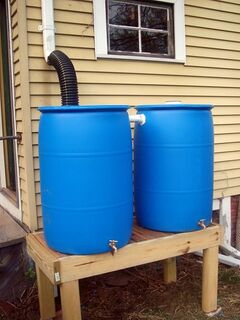Rainwater systems: Difference between revisions
m (→Rain Barrels) |
(→Rainwater collection methods: added another image of conjoined rain barrels, and a better image for the single rain barrel.) |
||
| Line 32: | Line 32: | ||
== Rainwater collection methods == | == Rainwater collection methods == | ||
=== Rain | === Rain Barrel === | ||
[[File:Rain | [[File:Rain barrel2.jpg|thumb|Image of a rain barrel with downspout. Note tap at bottom for high pressure output and overflow hose at top. Screw top lid of barrel affixes a mesh covering the opening of the barrel protecting against insects and detritus.]] | ||
This method is the fastest to get setup with and is popular as a readily-available backup solution. It involves installing a barrel at a gutter downspout to collect rainwater. The actual barrel may be a recycled barrel or a commercially available rain barrel. Some commercially available barrels are made of food grade plastics. UV resistant plastics can be a good idea, especially if the barrel cannot be installed in a location away from direct sunlight. It is important that the entrance hole to the barrel has a mesh or other filter to stop leaves and insects getting into the water. Wire or nylon mesh can be used, or even an old sieve. | This method is the fastest to get setup with and is popular as a readily-available backup solution. It involves installing a barrel at a gutter downspout to collect rainwater. The actual barrel may be a recycled barrel or a commercially available rain barrel. Some commercially available barrels are made of food grade plastics. UV resistant plastics can be a good idea, especially if the barrel cannot be installed in a location away from direct sunlight. It is important that the entrance hole to the barrel has a mesh or other filter to stop leaves and insects getting into the water. Wire or nylon mesh can be used, or even an old sieve. | ||
| Line 41: | Line 41: | ||
* Easily implemented by anyone at any residence | * Easily implemented by anyone at any residence | ||
* Barrels are readily available in your community or at various stores & websites | * Barrels are readily available in your community or at various stores & websites. Even an old trashbin can be cleaned and used. | ||
* Barrels don’t take up much space so they can fit into any situation | * Barrels don’t take up much space so they can fit into any situation | ||
| Line 47: | Line 47: | ||
* Capacity is generally small with the commercially available barrels | * Capacity is generally small with the commercially available barrels | ||
* It can easily overflow and so wastes water collection opportunities. | * It can easily overflow and so wastes water collection opportunities. | ||
=== Conjoined Rain Barrels === | |||
[[File:Rain barrels.jpg|thumb|An example of two rain barrels connected with an overflow pipe. The first barrel is fed via downpipe by rainwater collected from the roof. When it fills up, water travels over into the second barrel. Taps at the base allow for direct extraction of water | left | 240px]] | |||
This method employs one or more barrels connected to the intake rain barrel by way of an overflow pipe at the top. When the first barrel fills up, it overflows into the second, and so on. | |||
Pros: | |||
* Barrels are readily available in your community or at various stores & websites. Even an old trashbin can be cleaned and used. | |||
* Barrels don’t take up much space so they can fit into any situation | |||
* Overflow is managed such that excess water is not lost | |||
Cons: | |||
* Requires more skill to set up | |||
* Can be more expensive due to plumbing needs | |||
=== 'DRY' system rain barrels === | === 'DRY' system rain barrels === | ||
Revision as of 00:44, 4 July 2024
Article written here based on below links forthcoming.
Introduction

Municipal water networks are vulnerable to disaster events like earthquakes, flooding, pollutants and water shortages caused by drought or poor management. With a rainwater system a home or community can capture and collect water suitable for drinking, cooking and gardening even during periods where there is insufficient rainfall to satisfy the public water network. Other benefits cited by the collection of rainwater include reducing expense (in regions where water supply is not free), lowers local demand on freshwater resources, reduces risk of flooding in low-lying areas and slows erosion in dry environments[1]. Water is typically captured from a sloped roof, but it can also be captured from a structure deliberately built for the purpose.
Rainwater collection calculator
Formula
The formula to calculate the rainwater collected (RC):
RC = A * R * C
Where:
RC: Rainwater Collected (in liters or any desired unit) A: Collection Area (in square meters) R: Rainfall Intensity (in millimeters per hour) C: Collection Efficiency (expressed as a decimal or percentage)
Here, A could represent a roof area, and C is the effectiveness of your rainwater collection system. It takes into account factors like runoff, leaks and losses. You can express it as a decimal (e.g., 0.75 for 75%) or a percentage (e.g., 75%)[2].
Example in metric
Suppose you have a collection area of 60 m², a rainfall intensity of 10 mm/h, and a collection efficiency of 65% (0.65 as a decimal).
Using the formula: RC = 60 * 10 * 0.65 = 390 liters
390 liters of rainwater can be collected in this scenario.
Rainwater collection methods
Rain Barrel

This method is the fastest to get setup with and is popular as a readily-available backup solution. It involves installing a barrel at a gutter downspout to collect rainwater. The actual barrel may be a recycled barrel or a commercially available rain barrel. Some commercially available barrels are made of food grade plastics. UV resistant plastics can be a good idea, especially if the barrel cannot be installed in a location away from direct sunlight. It is important that the entrance hole to the barrel has a mesh or other filter to stop leaves and insects getting into the water. Wire or nylon mesh can be used, or even an old sieve.
Pros:
- Easily implemented by anyone at any residence
- Barrels are readily available in your community or at various stores & websites. Even an old trashbin can be cleaned and used.
- Barrels don’t take up much space so they can fit into any situation
Cons:
- Capacity is generally small with the commercially available barrels
- It can easily overflow and so wastes water collection opportunities.
Conjoined Rain Barrels

This method employs one or more barrels connected to the intake rain barrel by way of an overflow pipe at the top. When the first barrel fills up, it overflows into the second, and so on.
Pros:
- Barrels are readily available in your community or at various stores & websites. Even an old trashbin can be cleaned and used.
- Barrels don’t take up much space so they can fit into any situation
- Overflow is managed such that excess water is not lost
Cons:
- Requires more skill to set up
- Can be more expensive due to plumbing needs
'DRY' system rain barrels
This method is a variation of a rain barrel set-up simply involving a larger storage volume / barrel. The collection pipe connects to the top of the barrel and 'dries' after each collection. It is designed for less frequent and larger downpours.
Pros:
- Can store a large amount of rainwater
- Good for regions where rainfall occurs with less frequent storms
- Can be inexpensive to implement
Cons:
- Needs more space
- The storage tank must be located next to your house
Linkdump
Great overview of home-scale rainwater systems, with some handy calculations (Imperial) to help think through needs and supply
https://www.treehugger.com/beginners-guide-to-rainwater-harvesting-5089884
And another 101/overview, with a functioning roof surface catchment calculator
https://www.watercache.com/education/rainwater-harvesting-101
Article on care and cleaning of rainwater tanks
https://rainwaterharvesting.org.au/care-maintenance-of-rainwater-tanks/
Great collection of helpful images on rainwater harvesting
https://www.pinterest.ch/ServiceHomeTholen/rainwater-systems-regenwater-systemen/
Interesting article of a very low cost solution using multiple steel barrels
https://survivalblog.com/2017/04/19/rainwater-harvesting-an-easy-and-efficient-build-by-l-r/
The same low cost 'rain barrel' system outlined here, fed by downspout. This looks ideal for water infrastructure disruption fallback, to tie a household over for a week or so. They cite USD150 total cost:
https://www.treehugger.com/make-rain-barrel-system-at-home-5194982